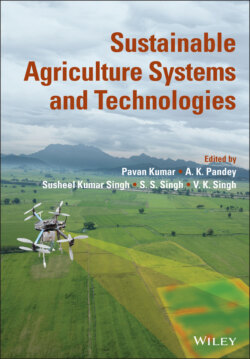Читать книгу Sustainable Agriculture Systems and Technologies - Группа авторов - Страница 12
Foreword 1
ОглавлениеRani Lakshmi Bai Central Agricultural University Jhansi, UP, India
Dr. Arvind Kumar Vice‐Chancellor Source: RLB Central Agricultural University
Modern agriculture depends heavily on engineering and technology and on the biological and physical sciences. Agriculture not only contributes to overall growth of the economy but also reduces poverty by providing employment and food security to the majority of the population in the continent, and thus it is the most inclusive growth sectors of the economy. In addition, growth in agriculture significantly influences the growth of nonagriculture sectors, also. Within the agricultural sector, smallholder farmers remain central to agricultural development and continue to play important roles promoting an ecologically rational and socially available food system. The ultimate goal or the ends of sustainable agriculture is to develop farming systems that are productive and profitable, conserve the natural resource base, protect the environment, and enhance health and safety, and to do so over the long‐term. In recent past, satellite technologies available for agricultural applications promise to offer multiple benefits to the growers like estimating the timing of harvest, predicting in‐season yields, understanding water and nutrient status, planning crop nutrition programmes and informing in‐season irrigation, forecasting in diseases and pests, etc. Advances in satellite constellations, payloads, and launch are enabling increased connectivity and observational capability. Coupling these developments with “smarter” computing, data infrastructures, and analytics is increasing the possibilities for the use of satellite technologies for multiple uses in agriculture. While this creates new possibilities for products, services, and decision support, it also requires proper planning to ensure that the latest technology is linked appropriately with production challenges and, therefore, can be used to deliver the gains required to meet the societal, economic, political, and environmental needs.
The compiled text encircles updated information on sustainable agriculture systems and technologies addressing a variety of areas related to food security within context of sustainable practices, crop modeling, irrigation practices, micro‐irrigation, agricultural statistics, agricultural economics, climate change scenario, flood routing, spatial modeling, farmers income, and agricultural policy in the twenty‐first century. This book would serve as a hand book encompassing several scopes of interests on sustainable technologies toward reliable practices and income generation in areas agriculture, livestock, and fishery resources for sustainable agriculture as a whole.
This book would be beneficial for academics, scientists, environmentalists, meteorologists, environmental consultants, computing experts working in the areas of agricultural sciences.
Arvind Kumar
